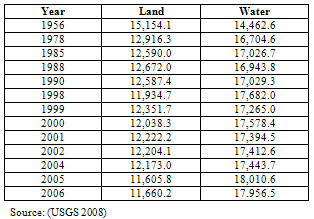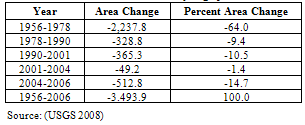-
Paper Information
- Next Paper
- Paper Submission
-
Journal Information
- About This Journal
- Editorial Board
- Current Issue
- Archive
- Author Guidelines
- Contact Us
Resources and Environment
p-ISSN: 2163-2618 e-ISSN: 2163-2634
2012; 2(1): 1-16
doi:10.5923/j.re.20120201.01
Using GIS and Climate Risks Information to Analyze the Vulnerability of Coastal Counties in Louisiana and Mississippi
Edmund C. Merem, Yaw Twumasi, Daphine Foster, Chandra Richardson, Sudha Yeramilli
Urban and Regional Planning, Jackson State University, Jackson, 39211, USA
Correspondence to: Edmund C. Merem, Urban and Regional Planning, Jackson State University, Jackson, 39211, USA.
| Email: |  |
Copyright © 2012 Scientific & Academic Publishing. All Rights Reserved.
This research assesses the vulnerability of coastal areas in the South eastern states of Mississippi and Louisiana using climate risk information. Emphasis is on the issues, and evaluation of the trends. In terms of methods, the paper uses GIS and descriptive statistics to map the trends. In the last several years, climate change impact continues to be felt in the Southeast especially the coastal zones. It has been predicted by scientists that many people could be affected by the impact of climate change risks in the Southeast coastal zones mostly from storms, high and extreme temperatures and others. As one of the most sensitive and vulnerable systems, coastal zones’ areas of concern include sea level rise, land loss, frequency of maritime storms, flooding and responses to sea level rise. Addressing the challenges associated with the threats of climate change in coastal areas of Mississippi and Louisiana, requires periodic assessment of the risks using geographic information systems. Without access to sufficient climate risk information management tools to measure the precise vulnerability of coastal zones areas, the ability of emergency managers and cities to mitigate the dangers posed to infrastructure, human lives and the economy will be diminished. The results show a spatial diffusion and a growing risk in vulnerable coastal areas in the two states. Utilizing climate risk data and GIS techniques to analyze the dangers faced in coastal cities helps minimize their vulnerability. The paper suggests the need for constant assessment and mapping of the risks.
Keywords: GIS, Climate Change, South East, Coastal Zones, Climate Risks
Cite this paper: Edmund C. Merem, Yaw Twumasi, Daphine Foster, Chandra Richardson, Sudha Yeramilli, Using GIS and Climate Risks Information to Analyze the Vulnerability of Coastal Counties in Louisiana and Mississippi, Resources and Environment, Vol. 2 No. 1, 2012, pp. 1-16. doi: 10.5923/j.re.20120201.01.
Article Outline
1. Introduction
- This research assesses the vulnerability of coastal areas in the South Eastern states of Mississippi and Louisiana using climate risk information and GIS. Emphasis is on the issues, and evaluation of the trends. The Southeast Gulf coast region is endowed with ecological assets that support the region’s economic wealth[1,2]. In the last decades, human activities from the construction of dams to shoreline expansion have considerably changed natural landscapes, streams, and ecological processes. Pressures from human activities remain the most important agents of ecological change in the region today[3]. As we move further into the 21st century, land-use changes are expected to rise as rapid population increases continue[4]. Global climate change, prompted by growing concentration of carbon dioxide and other heat trapping greenhouse gases in the atmosphere, will combine with, and amplify, other human pressures on theGulf Coast environments and the goods and services they offer[1,2,5]. Of the climate change scenarios in place, two expect both warmer temperatures and rising rate of sea level over the next 100 years. Under that scenario, summer high temperatures are projected to rise from 3 to 7 degree Fahrenheit and winter low temperatures to warm by as much as 5 degree Fahrenheit along the east and 10 degree Fahrenheit in the west. This will bring a remarkable growth in the July heat level in the Gulf coast of the Southeast[1,2]. Accordingly, the global sea level rise will affect the Gulf coast shoreline due to its flat topography, regional land subsidence, widespread shoreline development, and vulnerability to major storms[6]. Elsewhere climate models predict 8 to almost 20 inches sea –level rise along the Gulf coast in the next century[7]. Taking regional subsidence into account, the anticipated sea –level rise over the next 100 years could range from 15 inches in most of the Gulf Coast to as much as 44 inches along the Louisiana / Mississippi Delta [1,2,8-10]. Accordingly, in the last several years, climate change impact continues to be felt in the Southeast especially the coastal zones[11]. It has been predicted by scientists that many people could be affected by the impact of climate change risks in the Southeast coastal zones mostly from storms, high and extreme temperatures and others[1,2,8,9,12, 5]. As one of the most sensitive and vulnerable systems, coastal zones’ areas of concern include sea level rise and the responses to it, land loss, frequency of maritime storms and flooding[12,13,37,38]. To put the climate change parameters into perspective, one needs to consider the trends in the past few years. At a time when Hurricane Katrina left behind debris, downed trees, and soil erosion in its path, the Mississippi Department of Marine Coastal Preserves Program (DMR) was faced with a daunting task. In the aftermath, the DMR Coastal Preserves Program not only devoted available resources to restoring and protecting the Mississippi Gulf Coast’s sensitive habitats, but the challenges grew due to the impacts of the storm[14]. Regrettably, the huge toll from the disaster can be seen from the decimation of vital ecological features known to provide habitats and refuge for biodiversity and wildlife. These include the bayous, beaches, dunes, marshes, pine savannas and coastal forests in the area[15,16,17]. Other examples of notable impacts include the dangers posed by big areas of fallen trees, shredded and tattered marsh, and loads of debris covering huge areas, erosion of beaches and small creeks congested with debris and fallen trees. Furthermore, before Hurricane Katrina struck, Mississippi contained probably 3,000 acres of sea grasses. In going by current estimations, between 60 to 90% of the state’s sea grasses were either damaged or had vanished[15]. Louisiana as the home to the Globe’s seventh biggest delta is losing 25 – 50 square miles annually. Coastal Louisiana has already lost 1.2 million areas of wetlands this century and is losing additional 24 square miles of wetlands each year. Should climate change continue at the present pace, 70 percent of Louisiana’s remaining coastal wetlands would vanish by the end of the century. This will threaten numerous species. At the same time, continual sea level rise will considerably change the shape of Louisiana’s coastline devastating vital wetlands and letting saltwater seep into fresh water bodies, including crawfish ponds. Higher sea levels also imply higher storm surges that may arrive further inland. Global warming is expected to accelerate this trend in the coming decades making it even harder for waterfowl and other wildlife to thrive in the state[18,19].Southern Louisiana is the most endangered land in the US, this has caused a net sinking of the land, which in turn causes the wetlands on the Louisiana coast to recede inland as land sinks from under them. As Hurricane Katrina has shown, when these areas flood, they entrap residents and require enormous time to dry. With climate change accelerating the pace of ocean rise, it quickens the retreat of the wetlands and that raises the vulnerability of New Orleans further[20,21]. Climate change is projected to increase sea level by 3-10mm annually in the next five decades. This, combined with the subsidence of the Louisiana’s deltaic coast, possibly will result in sea level rise in the Gulf of Mexico from 60-180cm higher over the next century than they are today.Judging from the current land loss rate, by the year 2050 Louisiana will have lost an additional one million acres of coastal wetlands[22]. In addition, the sea will continue to move forward inland by as much as 33 miles during this period, transforming previously productive wetlands into open water and leaving New Orleans more exposed to sea flooding and hurricanes[10]. Several authors in the literature such as Greenland[23] (2005); [24]Alford (1985) and Simas [25] (2001) have also reaffirmed the growing concerns on the vulnerability of the State of Louisiana to the threats of climate change, in terms of the risks to sugarcane production in the producing areas as well as the evidence of river meander scars and the impacts on coastal marshes.In the absence of periodic applications of Geographic Information Systems (GIS) as a decision support tool to gauge vulnerability, decision makers risk overlooking the spatial locations and severity of these problems. This can accentuate the loss of lives in built environments and the degradation of natural areas in coastal environments of the region where the risk of climatic change runs high. The previous applications of GIS through other studies in the Southeast region of the US brought enormous benefits such as the spatial display of the emerging vulnerabilities. However, none of those studies focused solely on climatic variability and recurrent issues in the states of Louisiana and Mississippi. This research will fill that void in the literature. Detailed analysis through multiple studies of other GIS based applications to environmental change can be found under various years in the work of Merem and Twumasi[26-29].
2. Objectives and Organization
- The research has four objectives. The first aim is to analyze the current issues in climate risks. The second objective assesses the risks posed to the Southeast region while the third objective is to evaluate the potential climate hazards in the region. The fourth and last objective focuses on the identification of mitigation measures and the design of a decision support tool for policy makers. The paper is divided into six areas with the first area focusing on the introduction and background information. The second section describes the aims and organization. The methods and the study area description are covered in section three while the fourth section presents the results and the evaluation of the trends. The fifth section offers a discussion and findings of the research. The sixth and last section provides a closure and the future lines of action.
3. Methods and Study Area
- The method used in the study stresses the applications of Geographic Information Systems (GIS), spatial mapping and descriptive statistics in assessing climate change vulnerabilities of coastal counties in the study area of Mississippi and Louisiana. Addressing the challenges associated with the threats of climate change in coastal areas of Mississippi and Louisiana, requires periodic assessment of these risks using geographic information systems. Without access to sufficient climate risk information management tools to measure the precise vulnerability of coastal zones areas, the ability of emergency managers and cities to mitigate the dangers posed to infrastructure, human lives and the economy will be diminished. The paper uses climate risk information and related statistics based on descriptive statistics and Geographic Information Systems (GIS) to display the trends spatially.The initial step involves the identification of variables needed at the county and state levels from the various years. These variables are needed to assess climate change hazards at the county and state level. The variables consist of socio- economic and environmental information including wetland area, water area, land area of costal land, land area change, percentage of land area, farm income, population, damages from storms and hurricanes, number of hurricanes, their impacts, and risk level. The design of spatial data needed for the GIS analysis required the identification of appropriate digital county boundary lines covering the study periods. This entailed the assemblage of the electronic version of available hydrological and land cover and base maps indicating risks impacting the land base and the natural environment of coastal areas in the state of Mississippi and Louisiana for the different periods. This was made possible by the retrieval of spatial data sets of shape and grid files from the Mississippi Automated Resource Information System (MARIS) in digital form using ARCVIEW GIS. Other sources of data include NOAA, and the USGS. Given that the official boundary lines between several counties in the states stayed stable, it was possible to assign consistent geographic identifier code to the respective units in order to maintain analytical coherency. In the second stage, basic descriptive statistics was employed to transform the original data on environmental variables into relative forms. The statistical output of the variables from the spatial units were mapped and compared across time in ARCVIEW GIS. The process helped delineate the spatial locations and patterns of vulnerability, and the distribution of the risks within the study area across time.
3.1. Study Area Description
- The study area is the coastal areas of the Southeast states of Mississippi and Louisiana on the lower edge of the maps in Figure 1.0. The core cities in the coastal areas extend through the Mississippi River and the Gulf of Mexico. The Gulf of Mexico is characterized by the frequent occurrence of hurricanes. Sizable hurricanes have made landing in the Gulf Coast every year since 1994, with 26 named storms and 14 hurricanes occurring. The two states have a combined population of about 7 million from the census figures of 2010. Over the decades beginning from 1970 to 2010, the area has witnessed consistent population changes with the decade of 2000, and the 2010 being a period with more increases in population (Table 1.0). With the coastal areas of both states, known for their natural attractions, they continue to be centers of large development often threatened by extreme climate. Generally, both coastal areas before hurricane Katrina had a population of almost 2 million. The breakdown shows a population of 1.4 million for coastal Louisiana and almost half a million for South Mississippi coastal area[30].
 | Figure 1.0. Condensed Maps of Louisiana and Mississippi |
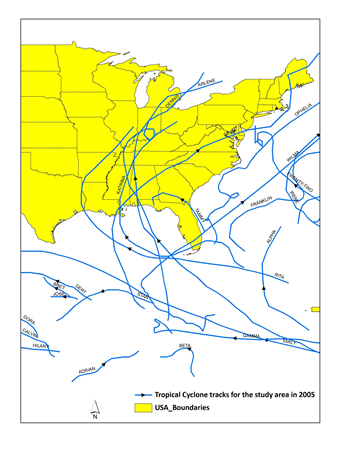 | Figure 1.1. The Paths of Tropical Cyclone for the Study Area in 2005 |
|
4. The Results and Environmental Analysis of the Risks
- To demonstrate the vulnerability of coastal areas from climate change, this section of the paper presents the results of the environmental analysis under different climate risk indicators (agriculture and water scarcity, agriculture and forestry, coastal land loss, coastal development infrastructure and others).
4.1. Agriculture and Water Scarcity
- As part of the GIS and spatial analysis under the rubric of agriculture and water scarcity, the impending risks from water scarcity in agriculture in both the states of Mississippi and Louisiana are presented. The analysis highlights these vulnerabilities using the top three crops. The GIS maps (in Figures 2.0 and 2.1) show a scenario built on the water supply sustainability index in 2050 for the study area. The maps are distinguished by four different classes separated by the colours of dark red, mild red, yellow and white. These colours denote four scenarios of extreme, high, moderate and low risks scales of water supply. The assumption is that climate change factors would impede access to continuous water supply for farmers in the top three agricultural products; corn, soybeans, and cotton for Mississippi, corn soybeans and rice for Louisiana within the farm producing areas in general as well as those located on the coastal areas of the two states. The agricultural crops under focus in the analysis as mentioned before are the top three cash earning staples worth billions of dollars annually in the respective states where agriculture and allied sectors remain major players in the economy. Clearly stated, the analysis is not meant as a forecast that water scarcity will ensue. But there is strong probability it will most likely happen in the areas under analysis going by present and future projections. This is based on changing temperature and fluctuations in other climatic variables in the Southeast region and across the United States in general in the last several years. In the process, the counties are grouped as ‘at‐risk’ based on the following criteria: expected demand for water from rain and snowmelt; expected requests from groundwater; propensity to drought; rise in freshwater pumpage; and rise in summer scarcity. Counties falling under two of the criteria are grouped as “moderately at‐risk”; those grouped under three or more criteria are rated as “highly at‐risk”; and those grouped in four or extra levels are grouped as “extremely at‐risk.” Counties not meeting up to two criteria are regarded as having low risk for water scarcity (Figures 2.0 and 2.1) In the case of Mississippi, it is evident, that the risk from acute water scarcity for agriculture from the map does convey the growing role of stress factors. These elements unleashed by extreme weather could be a major challenge in some parts of the state especially the Northern part known for cotton production and the overwhelming use of irrigation to boost farming. The predominantly coastal and southernmost portion of the Mississippi in the Gulf region of the state, based on the map also faces its own share of water scarcity big enough to affect agricultural activity as well.With about 76 at risk counties vulnerable to climate change impacts at different levels in the area, note a big concentration of the extreme forms of potential scarcity in the six major northern agricultural producing counties of Bolivar, Leflore, Washington, Sunflower, Humphries and Panola. The high levels of water scarcity risks on the other hand as the map shows, are scattered in 24 counties of the state within different geographic locations with much of it more visible in 11 northern counties, 6 in the central region and 8 in the southern area along the Mississippi Gulf area. The thing about this trend is its presence in the areas along coastal counties of Jackson, Pearl River, and Stone. This is followed by the moderate type of water scarcity threat stretching through a vast area of 45 counties covering all areas of the state including the two major southern coastal counties from Harrison to Hancock. Added to these, are the six low risk areas with minor probabilities of anticipated water scarcity as projected for 2050. The areas in the low risk category seem scattered in isolated patches from Northern Mississippi to the southern region of the state (Figure 2.0).In Louisiana, of the 52 at risk counties, one was classified as extreme, 19 high, 32 moderate and the remaining 12 under the low risk conditions. The only extreme category as shown in the map emerged in the Southwest part of the state at St Martin. Those in the high category appear evenly split in terms of spatial concentration among Northern and Southern Louisiana. The conditions for the high form of apparent water shortage in agriculture were not only quite visible along the southern part of Louisiana where 10 counties met the criteria, but they are also spread along a similar scale on the nine Northern counties from Grant to Morehouse, East and West Carol. The 34 counties classified under the moderate risk levels showed a major presence in all regions of the state with much of that apparent in the Northwest and central Louisiana. Apart from two low risk counties in the North, the remaining 10 counties in the category appeared in Southern Louisiana as well (Figure 2.1).
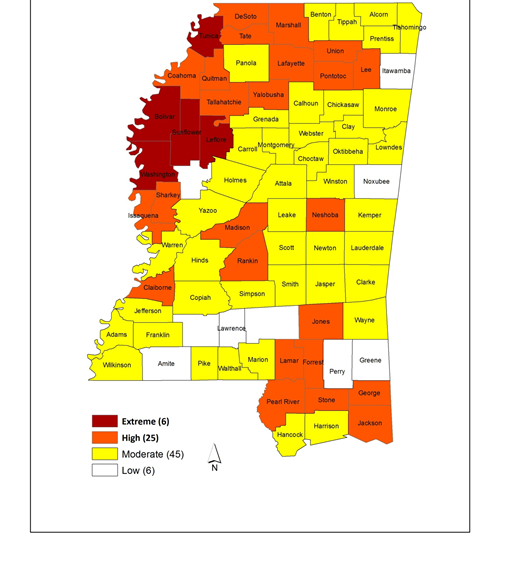 | Figure 2.0. Projected Climate Change Impacts On Water Access In Mississippi (Source: Tetratech 2010) |
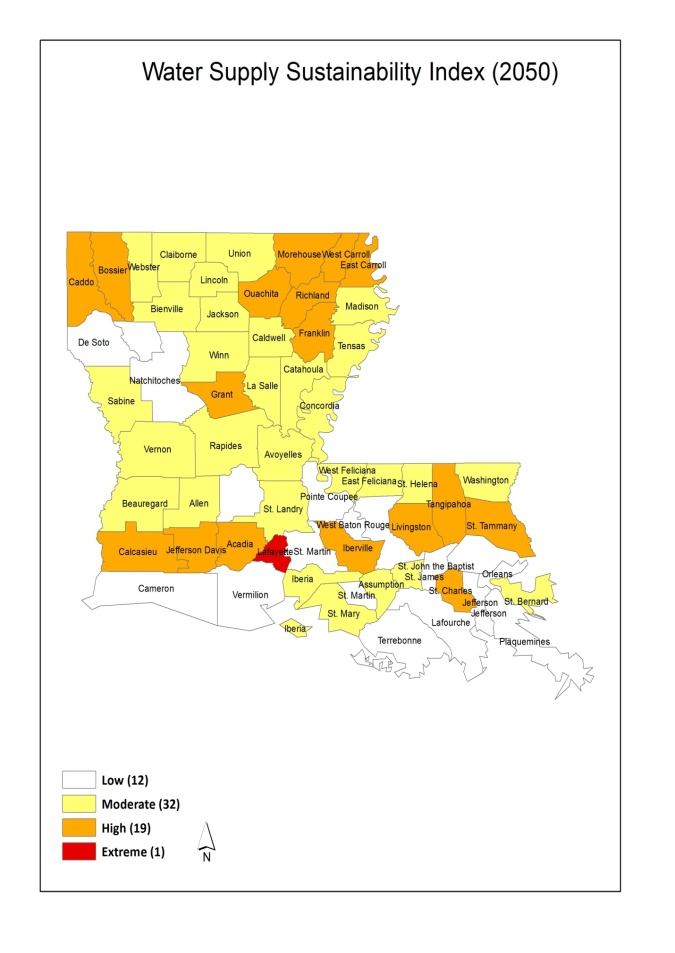 | Figure 2.1. Projected Climate Change Impacts On Water Access In Louisiana (Source: Tetratech 2010) |
4.2. Agriculture and Forestry
- Agriculture and forestry are both enormously important industries in both states .While in Louisiana they contribute over 10 billion each year to the state’s economy, the state of Mississippi earned about $7.1 billion from forestry most notably the managed shortleaf and loblolly pine. Each is very sensitive to climate change. In the delta region, where drier conditions are expected, rice farming will likely decrease, given its sensitivity to increased salinity. Under the drier conditions, extra irrigation will be essential to maintain the production of cotton, soybean, sorghum, hay, sugar cane and vegetables. Considering that soil fertility levels in the face of elevated C02 can only raise productivity with sufficient access to irrigation. It becomes imperative that agro-forestry production would diminish immensely at present levels in the absence of adequate irrigation water. The managed short leaf and loblolly pine tree forests in Louisiana which contributed $7.1 billion in 1997 are at risk to drought and fire in areas projected to go arid. With elevated temperature, the capacity of trees to take in carbon wanes. Savannahs and grasslands in both states will increase at the expense of forests, mostly in areas further inland from the coast if drier climate scenarios were to play out. Wetter climate conditions, on the other hand would boost the productivity of hardwoods at the expense of softwoods, but also favour the influx of forest pest such as Southern pine bark beetle[33].Additionally, agriculture in the southern part of the state would probably feel the greatest impacts of sea-level rise. This would affect the hydrology of low-lying coastal soils. Rice farmers in coastal parishes would be affected enormously by sea-level rise and elevated risks of salinity in groundwater. While warmer temperatures could boost citrus production in Plaquemines and St. Bernard Parishes, coastal land loss and salt-water intrusion would continue to adversely impact farmers in the area. With livestock accounting for 33% of the agricultural value in Louisiana, they are quite vulnerable to drought and other extreme climate conditions. Cattle farming in Vermillion Parish were plagued in September of 1998 by swarms of mosquitoes after a long-drawn-out down pour. The same flood water on which the mosquitoes hatched not only destroyed pasture grass, the rye grass essential for winter pasture became endangered by brackish water as well[34]. See Figure2.2 for the locations.
4.3. Coastal Land Loss
- Over the last two centuries, navigation channel dredging, oil and gas exploration and production, land reclamation, and the building of industrial facilities have damaged the Louisiana coastal region. This has resulted in primary and secondary wetland losses. These actions have impeded fresh accretion, lessened freshwater inflow and amplified saltwater intrusion. Other problems such as the impacts of accelerated wave energies on delicate interior marsh substrate have damaged growing vegetation, which would otherwise have held sediments and produced organic matter. Projecting future trends using the current land loss rate, by the year 2050, Louisiana will have lost over one million acres of coastal wetlands; this is bigger than the State of Delaware. At the same time, the Gulf of Mexico will continue to move forward inland at the rate of 33 miles during this period. This would gradually transform functional wetlands into open water that would keep major towns, like New Orleans and Houma, vulnerable to open waves and violent storms of the Gulf of Mexico[20].
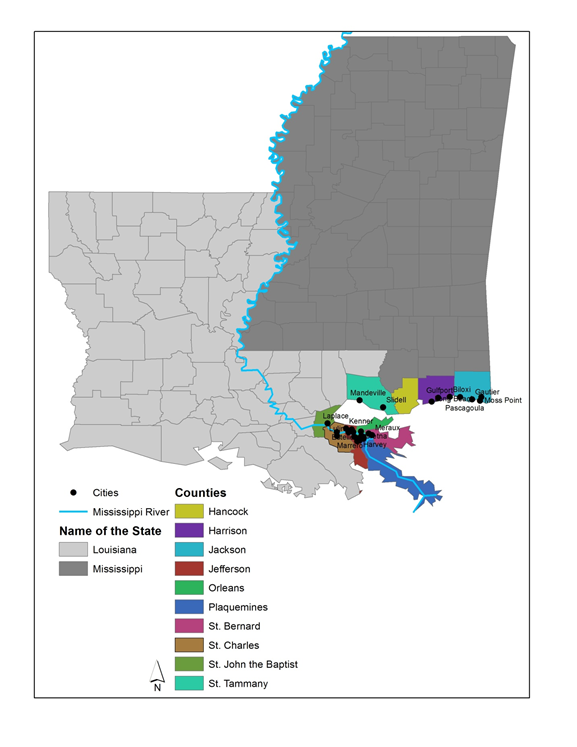 | Figure 2.2. Location of Climate Change Impacts In Agriculture, Forestry and Areas Vulnerable to Land loss, Sea Level Rise and Coastal Development Infrastructure Impact |
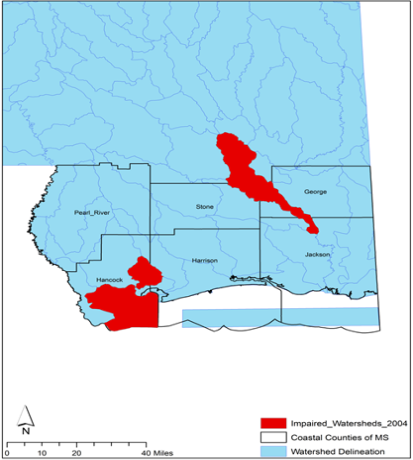 | Figure 2.4. The Location of Impaired Watersheds In Southern Mississippi |
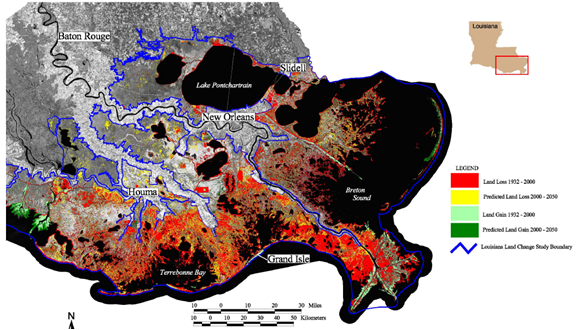 | Figure 2.3. Projected Coastal Land Loss In Louisiana (Source: USGS) |
4.4. Coastal Development, Infrastructure and Sea Level Rise
- As development and economic activity in coastal areas has increased, so, too, has societal vulnerability to coastal hazards. Global climate change will likely exacerbate that vulnerability. Essentially, the area South of New Orleans, which is highly developed for residential, industrial and tourism activities coupled with the international seaports of New Orleans and Baton Rouge, operating also as important transportation hubs with other smaller docks remain vulnerable. While much of the coastal fringe of Louisiana and Mississippi is rural and not overly developed, their low-lying areas face growing challenges from sea level rise. These areas not only contain toxic release inventory sites that are hazardous, but there are numerous oil wells, refineries, offshore platforms as well that could be swept away. Additionally, accelerating sea level rise due to global warming will heighten the pace of erosion in the area. This is already a major threat to residences, roads and other infrastructure along the shorelines of Louisiana’s barrier Islands such as Grand Isle.
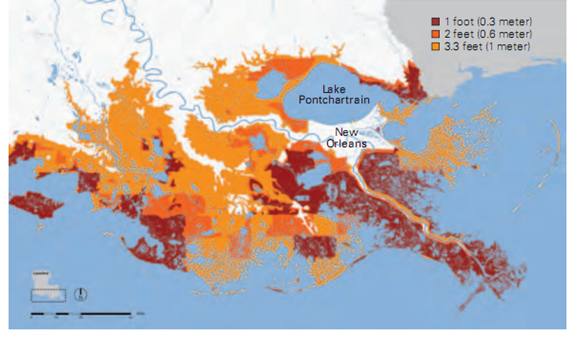 | Figure 2.5. Anticipated Coastal Wetlands Submersion at 1 to 3.3 feet relative sea level by 2100 For Louisiana (Source: NRDC 2011) |
 | Figure 2.6. The Locations of Toxic Release Inventory sites in coastal mississippi |
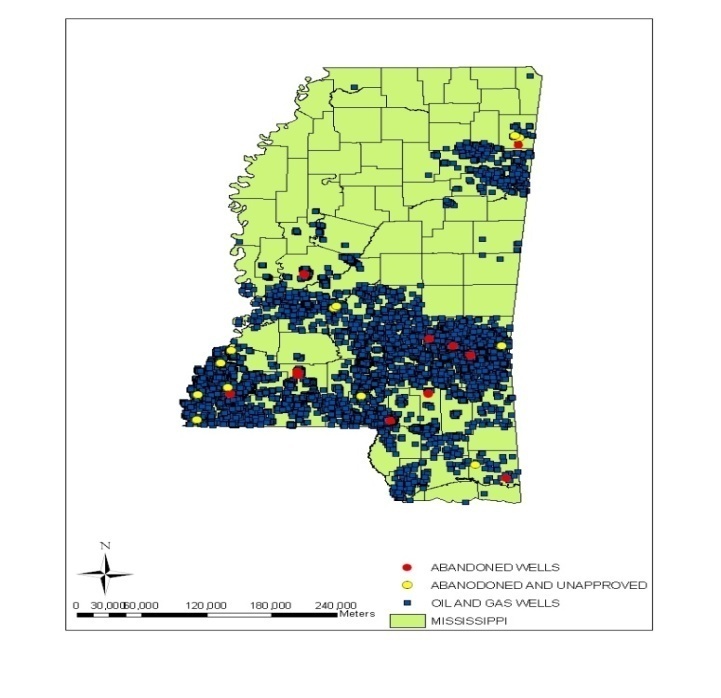 | Figure 2.7. Figure The Location of Oil Wells In Missssippi |
 | Figure 2.8. Location of of Oil and Gas Wells In Lousiana |
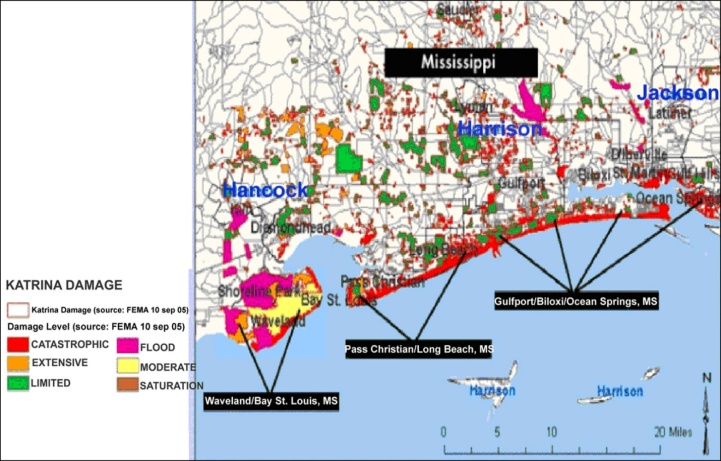 | Figure 2.9. Damage Assessment of Southern Mississippi in 2005 After Hurricane Katrina. (Source :FEMA, 2005) |
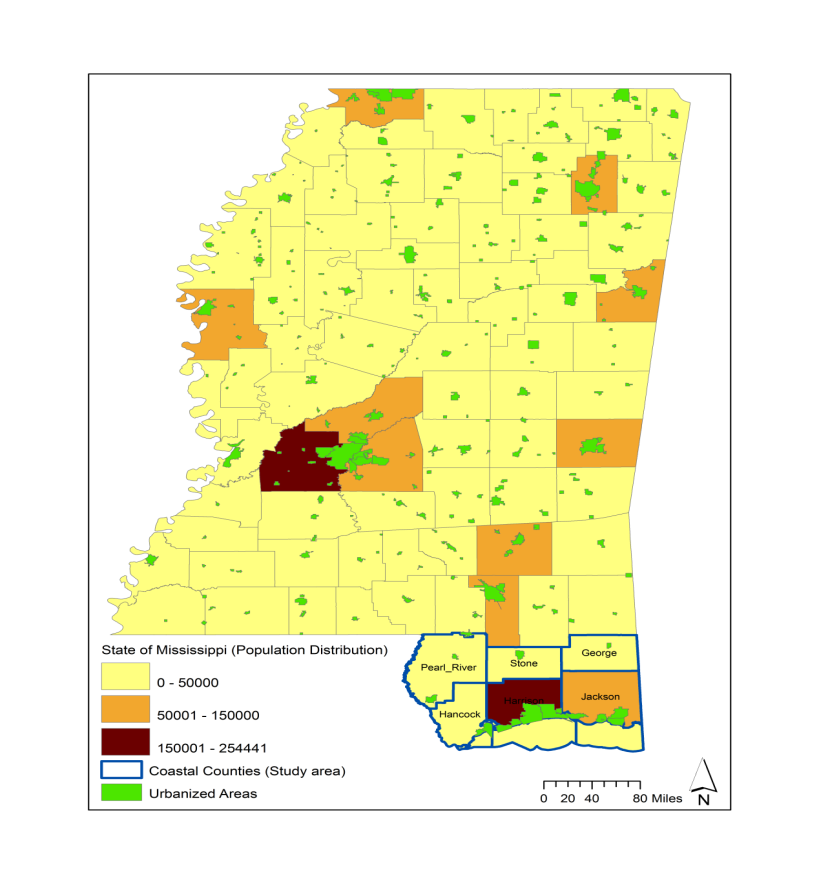 | Figure 2.10. The Population Distribution For Mississippi and The Coast |
5. Discussions and Findings
- From the analysis, coastal areas in the study area remain quite vulnerable to the threats of changing weather patterns unleashed from climate change. This continues to be felt in various forms along the Southeast region especially the coastal zones of Louisiana and Mississippi[37,38]. This section of the paper offers a synopsis of the findings and the results of the data analysis. Overall, the study area has experienced numerous cases of changing weather patterns along the coastal environment. This is evident with recurrent cases of storms and cyclones as shown in the study area analysis[37,38]. Regarding, the issue of anticipated water shortage in agriculture, the paper shows that at- risk counties in Louisiana and Mississippi will not only be threatened, but their current agricultural operations and practices, and the local commerce remains highly vulnerable by 2050 should the scale of anticipated climate change scenario hold. Another thing to glean from spatial distribution of these risks in 2050, is the vicinity of the at risk counties to the major aquifers of the state as well. With the current demands and pumpage levels of ground water for agricultural activities becoming overly high in the states due to competing demands from the other sectors of the economy, including residential, industrial and the others. The adjoining aquifers and underground water bodies face the threats of salt water intrusion. This would likely compound the problems in areas where farm products and the ecosystem have low tolerance for the excessive levels of salt water intrusion most likely to emerge from rising temperatures in these areas.From the analysis, coastal land loss is another area of concern in the study area of Louisiana and Mississippi. If global warming continues at the current rate, 70 percent of Louisiana’s remaining coastal wetlands will be gone by the end of the century. This will endanger many species and the sensitive habitats that provide these creatures critical refuge. More so, continued sea level rise will dramatically alter the shape of Louisiana’s coast line destroying more critical wetlands and letting saltwater seep into fresh water bodies, including crawfish ponds. Higher sea levels also mean higher storm surges that reach further inland. In addition, the Gulf of Mexico will continue to advance inland as much as 33 miles during this period, turning previously functional wetlands into open water. This will keep major towns and cities, such as New Orleans and Houma, exposed to violent storms from the Gulf of Mexico. The state of Mississippi has many diverse upland and wetland habitats; but nowhere in the state can you find habitats, that are more functionally important than the dynamic coastal wetland habitats located along the beautiful Mississippi Gulf coast in Hancock, Harrison and Jackson counties. Considering the role of the ecosystem in providing habitats for biodiversity, the south Mississippi coastal areas have also experienced their own share of wetland loss. These habitats are also under the threats of human activities as well as climate change risk factors as well. The marshes of Point Aux Chenes Bay, Jackson County are being eroded away faster than any other marsh area in the state of Mississippi. This poses a major threat to the stability of the coastal ecosystem. The problem of the study area is further compounded by the growth in infrastructure development within the coastal counties prone to the threats of the rising sea levels and sea surge prompted by hurricanes and costal storms. Just as the facilities hosting toxic release inventory are at risk due to the frequency of violent storms and storm surge, so are the oil and gas facilities, wells and offshore platforms in the area. In 2005, both natural and built environments in coastal areas of Mississippi and Louisiana were severely obliterated by Hurricane Katrina. Future climate projections for the area show that, the intensity of these hazards would grow much stronger in the coming decades with the continuous exposure of the coastal areas to further risks[37,38]. Furthermore, fresh water ecosystem, aquaculture and fishery and human health in coastal areas of the study area are all at high risk from climate change factors now and in the coming years. Judging from the extent of spatial distribution of the trends and the risk levels projected for the coastal areas of the two states, it is evident, that addressing the challenges associated with the threats of climate change in coastal areas of Mississippi and Louisiana, requires periodic assessment of the risks using geographic information systems. From the spatial mapping of the trend using GIS, the results show a spatial diffusion and a growing risk in the vulnerable coastal areas of the two states. Much of the damages suffered during hurricanes showed more concentration in the coastal areas of the study area. Projected losses of coastal marshes, and land stayed firm in the areas adjoining coastal zones of both states. In other words, there seem to be a coastal flavour to the impending risks from climate change projected for the area. Without access to spatial data sets and mappings made possible through GIS, the ability to predict and locate these risks across space would have been difficult. Therefore, utilizing climate risk data and GIS techniques to analyze the dangers faced in coastal cities of the study area helps emergency planners in making quick judgments about mitigation measures. This helps in minimizing the vulnerability of the areas herein analysed. In terms of future lines of action and recommendations, the paper suggests the need for continuous assessment, education, emergency planning, regular tracking of climate change and mapping of the risks in the years ahead. In light of this finding, the practical use of a mix scale approach involving primary data and GIS helped track the extent and location of environmental vulnerabilities prompted by climate change factors. The utility of GIS in tracking coastal climate risk factors stands an update to the current literature. This is essential in the assessment of risks in coastal ecosystems such as the Southeast region of Mississippi and Louisiana. Considering that minor efforts were made in the past to examine climate change issues and the risks to the Southeast regional ecosystem, GIS technology as used in this paper has fulfilled a useful purpose in mapping the current problems and the impending risks and the critical spots in the study area. Accordingly, the paper stands as an effective tool for climate risk management and environmental monitoring in a coastal ecosystem. Integrated data analysis using climate risk information and GIS facilitated the analysis of spatial diffusion of climate risk factors threatening the coastal areas of Louisiana and Mississippi.
6. Conclusions
- This research began by assessing the vulnerability of coastal areas in the Southeastern states of Mississippi and Louisiana using climate risk information. The paper identified the prevailing issues, and evaluation of the trends. To analyze the trends, the project adopted the mix scale methods of GIS connected to descriptive statistics to map the trends. Based on the analysis, it is evident that, the study area’s coastal regions continued to experience the risks posed by climate change impact. The extent of these risks in the Southeast states of Mississippi and Louisiana especially the coastal zones can be manifested by the intensity of anticipated hazards to ravage both the natural and built environments in the area and the current frequency of hazards.The current and anticipated vulnerabilities for the Southeast coastal zones of Louisiana and Mississippi would stem from a variety of risk factors. This would mostly come from storms, coastal land loss, loss of barrier islands, flooding, high and extreme temperatures and sea level rise. Other risk factors embody damages to fresh water ecosystem due to salt water intrusion, water scarcity in agriculture, threats to human health, and the growing hazards from coastal development infrastructure in geologically unsteady terrains along the shorelines[38].Addressing the challenges associated with the threats of climate change in coastal areas of Mississippi and Louisiana, requires periodic assessment of the risks using geographic information systems. Without access to sufficient climate risk information management tools to measure the precise vulnerability of coastal zones areas, the ability of emergency managers and cities to mitigate the dangers posed to infrastructure, human lives and the economy and the environment will be diminished. The results show a spatial diffusion and a growing risk in vulnerable coastal areas in the two states[38]. Utilizing climate risk data and GIS techniques to analyze the dangers faced in coastal cities of the study area helps minimize their vulnerability. The paper offered numerous suggestions including the need for continuous assessment and mapping of the risks.The practical applications of a mix scale approach involving Geographic information Systems (GIS), spatial mapping along with climate risk data, as analytical tools have added another dimension to the literature. This tool has been effective in detecting the vulnerabilities of coastal areas of Louisiana and Mississippi to the dangers of change and degradation partly prompted by coastal development, human activities and natural factors. While the analysis showed some interesting results for the Southeast coastal region of the US. It is evident that descriptive statistics, climate risk data and spatial mapping and GIS quickened the detection of the geographic diffusion of the risks of water scarcity, wetland loss, coastal development infrastructure, the degradation unleashed from storms, sea level rise and others. In closing, it is our belief that successful implementation of some of the strategies outlined herein could lead to effective climate risk management in the South east region[38].
Appendices
Appendix A
- Water Shortage Index For Louisiana
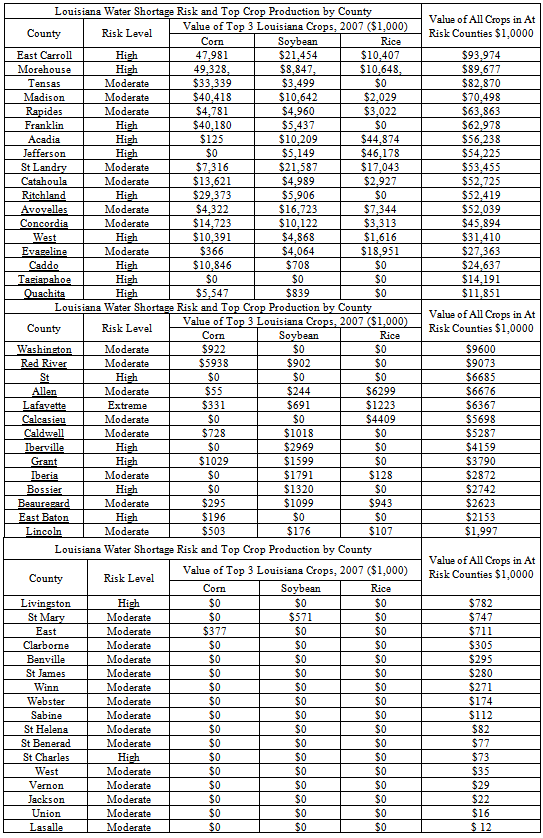
Appendix B
- Water Shortage Index For Mississippi

Appendix C
Appendix D
Appendix E
- Fisheries and AquacultureMississippi is home to the most lucrative aquaculture operation in the United States, producing food fish, bairfish, shrimp, crawfish and Oysters with an annual value of $290 million. The state’s fishing industry is also ranked the second biggest among the five Gulf states which is mostly reliant on stable coastal wetlands and clean coastal waters[9]. Just as Mississippi, Louisiana has a lucrative fish and sea food industry. The state’s aquaculture industry, known for the production of food fish, bairfish, shrimp, crawfish and Oysters is ranked seventh nationally in the US. Coastal Louisiana often called the crayfish hub of the globe is extremely sensitive to fluctuations in the availability of fresh water and to salt water seepage into crayfish ponds[8]. The growing pace of sea level rise and drops in precipitation in coastal areas will amplify the risk of permanent or occasional salt water intrusion into these ponds, thereby drastically affecting production in both states. Based on the existing climate models, there would also be higher salt concentrations, less nutrient input, less flushing and overall less quality water in the near shore waters in these areas as well. If the salt tolerance level of organisms in marshes, mangroves and sea grass-beds is surpassed, fluctuations in the food web and possible drop in fish and shell fish harvest would occur in both states. Should wetlands migration occur inland as sea level rise continues, the production of estuarine dependent fisheries, such as shrimp will either grow or drop depending on the dimension and quality of the new habitat across time[9]. Fresh Water Resources The current populations in the study area have been put at 2.8 million for Mississippi and 4.5 million for Louisiana. Both numbers are projected to increase to about 3.1 million by 2025 and 5 million in 2020 respectively. The states freshwater resources will be more and more used up for city development, agricultural irrigation, the containment of salt water intrusion into coastal aquifers, and aquaculture and the preservation of healthy ecosystems will be critical. These competing demands on limited freshwater will trigger fresh water resource challenges[9,8]. In coastal areas, the threat to freshwater resources will come from the combined effect of salt water intrusion due to sea level rise and the projected decrease in rain fall. Salt water intrusion also threatens freshwater withdrawals from the Mississippi River and other areas such as Bayou Lafourch. As global warming continues, more climate extreme events will accelerate frequent runoffs likely to over stretch sewage systems. This would result in the pollution of surface and coastal waters with grave consequences for public hygiene and the fishing sector. Where salt water intrudes into coastal ground water source as a result of sea level rise, fresh water resources could be at risk. Similarly, saltwater intrusion into fresh water marshes also impedes vegetation with low salt tolerance in a manner that alters the composition and functional capability of the ecosystems. Higher water temperatures will alter aquatic ecosystems by changing aquatic food webs and the ecosystems. Such extreme temperatures will impact water quality by reducing the amount of dissolved oxygen with extreme cases of fish death[9,36]. In fact, increased salinity since the 1950 has resulted in the decline of bald cypress forests in Louisiana[3]. Human HealthHealth problems linked to global warming come from a multifaceted mix of interacting human and ecological factors. While these are chiefly critical for seniors and other susceptible groups, air and water quality, seafood safety and storm related concerns pose a major risk for most residents and visitors. With the July temperature level expected to intensify mainly in Southern United States. Urban areas such as Baton Rouge, New Orleans, Shreveport and Jackson Mississippi are principally at risk to extra heat waves. Both states would experience rising number of heat related casualties especially among senior citizens and the populations at the margin. In fact, poor and young people who are unable to protect themselves from heat waves would have hard times surviving. Rising temperature will also trigger bigger production of ground level ozone, which, when mixed with elevated levels of air pollutants and higher pollen counts, could seriously diminish air quality[8].Metro areas such as Baton Rouge, already cited as in non-compliance with federal air quality standards, will probably experience far more bigger problems. On Louisiana’s coast, viral and bacterial contamination of shell fish has frequently caused sicknesses resulting in the closure of vital fisheries. The protozoan Perkisnsus marinus stands as the most deadly pathogen menacing the Gulf’s important oyster industry. The frequency of P marinus has been linked to salinity and temperature, with low temperatures and salinities inhibiting infections and higher temperatures and rising salinities usually escalating it. Climate change will probably create favourable conditions for the breeding of P marinus. This will in turn threaten the stability of marine ecosystem in the study area[8].
References
| [1] | Twilley, Robert. 2001a. Confronting Climate Change In The Gulf Coast Region --- Prospects For Sustaining Our Ecological Heritage. Executive Summary The Union of Concerned Scientist , Cambridge, MA pp IX-XIV |
| [2] | Twilley, Robert. 2001a. Confronting Climate Change In The Gulf Coast Region --- Prospects For Sustaining Our Ecological Heritage. Chapter 1 Climate and People as Derivers of Ecosystem Change Summary The Union of Concerned Scientist , Cambridge, MA pp 1-14 |
| [3] | Burkett, Virginia. 2007 April. Hearing On the State of Climate Change Science 2007: The Findings of the Fourth Assessment Report By the Intergovernmental Panel on Climate Change Impacts, Adaptation and Vulnerability. pp 1-9 |
| [4] | Brown,Oli.2006 Migration and Climate Change. International Journal for Migration, IOM Geneva. Switzerland |
| [5] | Tibbets,John.2007.Winter. Rising Tide. Will Climate Change Drown Coastal Wetlands. Coastal Heritage. 21:1: 2-14 |
| [6] | NOAA Coastal Services Center. 2009 February. Local |
| [7] | Strategies For Addressing Climate Change. Charleston. South Carolina . pp 1-24 |
| [8] | Jacob, John J. 2008. The Resilient Coast; Policy Frameworks For Adapting The Built Environment. To Climate Change and Growth In Coastal Areas of The US Gulf of Mexico. Texas A&M University 1-37 |
| [9] | Twilley, Robert. 2001b. Confronting Climate Change In The Gulf Coast Region --- Prospects For Sustaining Our Ecological Heritage, Louisiana. The Union of Concerned Scientist , Cambridge, MA pp 1-4 |
| [10] | Twilley, Robert. 2001 c. Confronting Climate Change In The Gulf Coast Region --- Prospects For Sustaining Our Ecological Heritage, Mississippi. The Union of Concerned Scientist , Cambridge, MA pp 1-4 |
| [11] | Anthony, Abigail. 2009. Coastal Lagoons and Climate Change: Ecological and Social Ramification In US. Atlantic and Gulf Coast Ecosystems. Ecology and Society 14:18;1-30 |
| [12] | Jacob, John J. 2007. The Resilient Coast; Policy Frameworks For Adapting The Built Environment . To Climate Change and Growth In Coastal Areas of The US Gulf of Mexico. Texas A&M University 3-40 |
| [13] | Jones, Sonya. 2010. Climate Change ----Science In The South East. US Geological Survey. South East Area |
| [14] | Rubunioff, Pamela. 2008 February. Summary of Coastal Program Initiatives That Address Sea Level Rise As a Result of Climate Change. Rhode Island Sea Grant / Coastal Resources Center. University of Rhode Island pp 1-50 |
| [15] | Louisiana –Mississippi Gulf Coast Ecosystem Restoration Working Group. 2010 March. Road Restoring Ecosystem Resiliency and Sustainability. pp 1-8 |
| [16] | Mississippi Department of Marie Resources. 2005 Fall. Coastal Markers vol 9:2:1-9 |
| [17] | USGS. 2010 December. Forecasting The Effects of Land Use and Climate Change On Wildlife Communities and Habitats In The Lower Mississippi Valley. Fact Sheet, 201:12-3112. US Department of Interior |
| [18] | USGS. 2010. Coastal Change Hazards: Hurricanes and Extreme Storms. St Petersburg Coastal and Marine Science Center. US Department of Interior St Petersburg, Florida. pp 1-6 |
| [19] | USDA. 2005. Climate Change Impacts to Louisiana. Washington. DC: United States Department of Agriculture |
| [20] | Twilley, Robert. 2007 December. Environment: Coastal Wetlands and Global Climate Change. Gulf Coast Wetland Sustainability In a Changing Climate. Baton Rouge, Louisiana State University/Pew Center. pp 1-18 |
| [21] | Carbonnel, Armando. 2009. Climate Change and The Resilience of New Orleans: The Adaptation of Deltaic Urban Form. Cambridge MA |
| [22] | Kazmieczak, A. 2010. New Orleans: Preserving The Wetlands to Increase Climate Change Resilience. Adaptation to Climate Change Using Green and Blue Infrastructure: A Database of Case Studies, pp 1-10 |
| [23] | USGS 2008. Land Area Change In Coastal Louisiana: A |
| [24] | Multidecadal Perspective: From 1956 to 2006. US Department of Interior; Reston, Virginia. pp 1-6 |
| [25] | Greenland, David. 2005 November. Climate Variability and Sugarcane Yield In Louisiana. Journal of Applied Meteorology 4:.1655-1666 |
| [26] | Alford, John. 1985. Meander Scars As Evidence of Major Climate Change In South West Louisiana. Journal of The American Association of Geographers. 395-403 |
| [27] | Simas, T. 2001. Effects of Global Change On Coastal Slat Marshes. Ecological Modeling.139.1-15 |
| [28] | Merem, E.C. and Y.A Twumasi 2008 March a .Geospatial Information Systems Analysis of Regional Environmental Change Along The Savannah River Basin of Georgia; International Journal of Environmental Research and Public Health. 5: 1:281-294 |
| [29] | Merem, E.C. and Y.A Twumasi. 2008 December 31st b). Using Spatial Information Technologies as Monitoring Devices In International Watershed Conservation along the Senegal River Basin of West Africa The International Journal of Environmental Research and Public Health, 5:5: 464-476 |
| [30] | Merem, E.C. and Y.A Twumasi. 2010 May. Using GIS In Environmental Management: Green Assessment of The Impacts of Petroleum Activities In The State of Texas. The International Journal of Environmental Research and Public Health, 7:5: 2101-2130 |
| [31] | Merem, E.C. and Y.A Twumasi. 2011 June 23rd. The Applications of GIS in the Analysis of the Impacts of Human Activities on South Texas Watersheds International Journal of Environmental Research and Public Health 8:6: 2418-2446 |
| [32] | Environmental Defense Fund. 2010. Hurricanes and Climate Change; Louisiana’s Coast: What’s at Stake. pp 1-2 New York, NY |
| [33] | Working Group For Post-Hurricane Planning For Louisiana Coast. 2006 January. A New Framework For Planning The Future of Coastal Louisiana After The Hurricanes of 2005. Integration and Application Network. University of Maryland Center For Environmental Science. Cambridge Maryland. pp 1-48 |
| [34] | Kathryn E.I 2009. A Review of Land-cover Mapping Activities In Coastal Alabama and Mississippi. USGS- US Department of Interior Reston, Virginia. pp 1-18 |
| [35] | Bloomfield, Janine. 2000. Impacts of Climate Change In The United Sates On Forests. Environmental Defense Fund.pp 1-6 |
| [36] | Tutwiler, Mary. 1999 May. Danger and Opportunity: Implications of Climate Change For Louisiana. A Report For Louisiana State Legislature To Fulfill House Concurrent Resolution 74, Regular Session. Legislative Study Group, HCR 74; Baton Rouge LA |
| [37] | Mississippi Department of Marine Resources. 1999 January. Mississippi’s Coastal Wetlands. Coastal Preserves Program. Biloxi, MS. pp 2-19 |
| [38] | Rabalais,Nancy. 2009 March. Global Change and Eutrophication of Coastal Water. ICES Journal of Marine of Sciences .1-10 |
| [39] | Burkett, Virginia. 2011. Potential Impacts of Climate Change and Variability On Transportation In The Gulf Coast / Mississippi Delta Region . USGS, Lafayette LA |
| [40] | Day, John. 2009 November. Biophysical Economics: The Mississippi Delta As A Lens For Global Issues. Earth Magazine1-5 |
 Abstract
Abstract Reference
Reference Full-Text PDF
Full-Text PDF Full-text HTML
Full-text HTML
